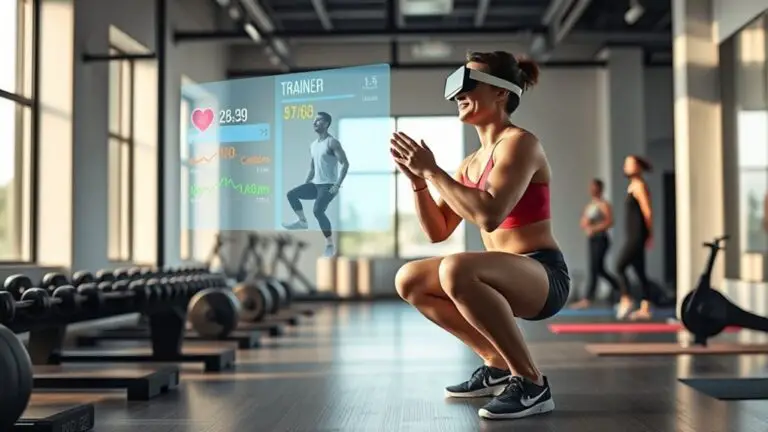The Best Gym Programs for Kids and Young Athletes
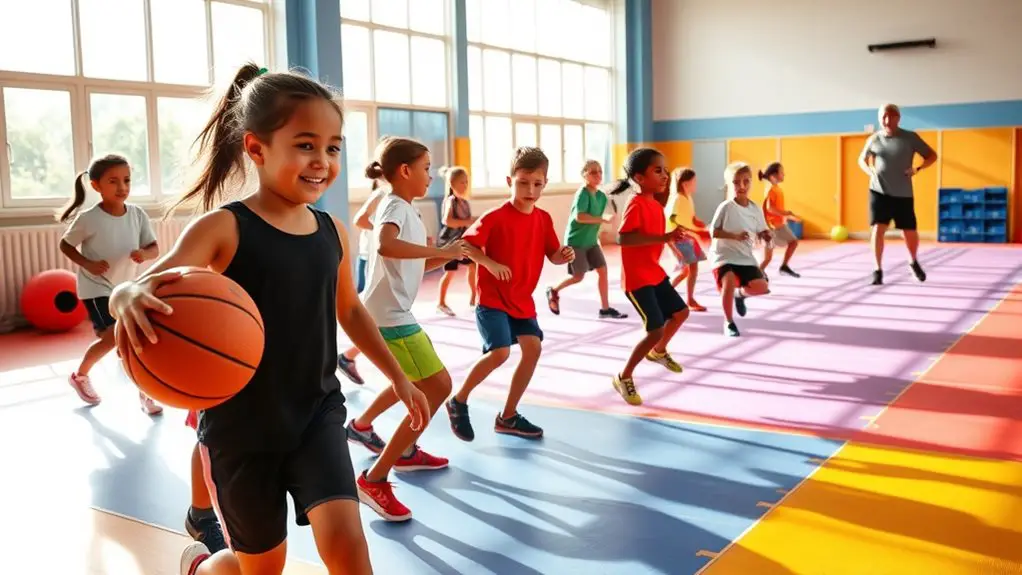
When choosing the best gym programs for kids and young athletes, look for options that promote physical growth and skill development in a fun and supportive environment. Popular programs include CrossFit Kids, gymnastics, and martial arts, each encouraging teamwork, social skills, and a lifelong love for fitness. Structured initiatives can combat childhood obesity and instill healthy habits. If you want to know more about selecting the right program for your child, there’s plenty to explore further.
The Importance of Physical Fitness for Kids
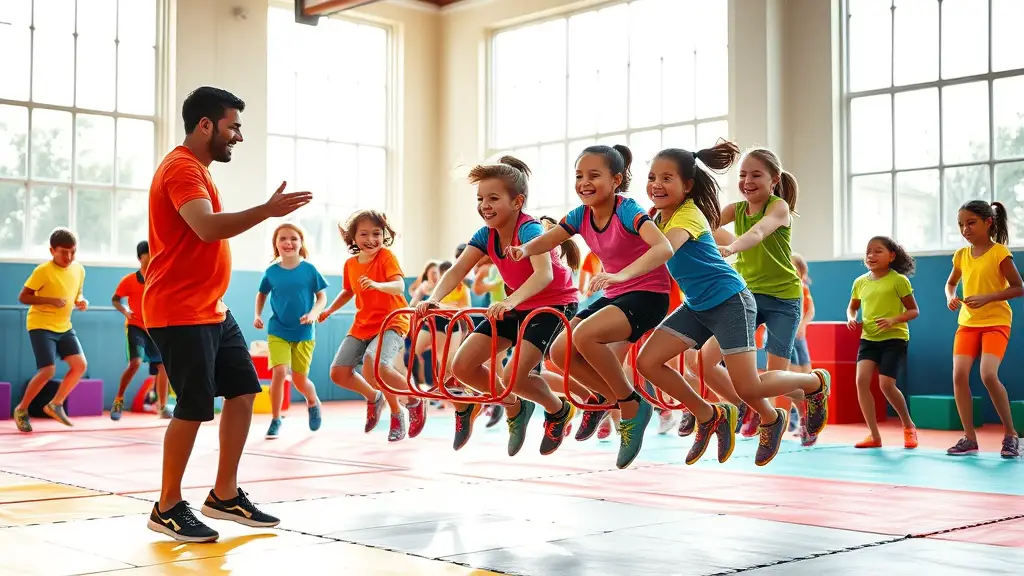
Physical fitness is essential for kids, as it lays the foundation for a healthy lifestyle and fosters overall well-being. Engaging in regular physical activity helps combat childhood obesity, a growing concern affecting many families today. By encouraging your child to stay active, you’re not only promoting a healthy weight but also instilling lifelong habits that can lead to better physical and mental health.
Fitness motivation plays a significant role in keeping kids active. When children find activities they enjoy, they’re more likely to stick with them. Whether it’s sports, dancing, or simply playing outside, the key is to make movement fun and engaging. Establishing a routine that incorporates physical activity can boost their confidence and self-esteem while reducing stress and anxiety. By prioritizing fitness, you’re setting your child up for a brighter, healthier future.
Key Elements of an Effective Gym Program
When designing a gym program for kids and young athletes, it’s essential to include age-appropriate exercises that match their developmental stage. Focusing on skill development not only enhances their abilities but also keeps them motivated. Plus, incorporating fun elements can make the experience enjoyable, fostering a lifelong love for fitness.
Age-Appropriate Exercises
Incorporating age-appropriate exercises into gym programs for kids and young athletes is essential for fostering their physical development and guaranteeing safety. For younger children, focus on bodyweight exercises like squats, push-ups, and lunges, which help build strength without the risk of injury from heavy weights. As they grow, introducing coordination drills such as agility ladders or cone drills enhances their motor skills and balance. These exercises not only promote physical fitness but also boost confidence and encourage a lifelong love for movement. Tailoring activities to their developmental stage guarantees they’re engaged and challenged, paving the way for success in sports and everyday activities. Remember, a fun and safe environment is key to keeping them motivated!
Skill Development Focus
To guarantee kids and young athletes thrive in their gym programs, a strong focus on skill development is essential. Effective programs should begin with a thorough skill assessment to identify each athlete’s strengths and areas for improvement. This personalized approach guarantees that training is tailored to their unique needs.
Next, emphasize technique refinement to help them master fundamental movements. Proper technique not only enhances performance but also reduces the risk of injury. Incorporating drills that target specific skills, such as agility, coordination, and strength, will build a solid foundation for future athletic endeavors.
Fun and Engagement
While skill development sets the groundwork for athletic success, the element of fun and engagement is what truly captivates kids and young athletes in a gym program. Incorporating creative games and interactive challenges not only makes workouts enjoyable, but also fosters a love for physical activity. Research shows that when kids are engaged, they’re more likely to stick with an exercise routine. For example, you might implement relay races or obstacle courses that encourage teamwork and friendly competition. These activities not only enhance physical skills but also build social connections. By prioritizing fun, you’ll keep athletes motivated, promote a positive environment, and ultimately help them develop a lifelong passion for fitness. So, let’s make every workout an adventure!
Popular Gym Programs for Young Athletes
Many kids today are enthusiastic to engage in structured gym programs that not only improve their physical fitness but also enhance their athletic skills. Popular youth training programs often include strength conditioning, agility drills, and sport-specific skills. These programs focus on developing core strength and coordination, which are essential for any young athlete.
Fitness challenges like obstacle courses and timed sprints are also frequently incorporated to keep kids motivated and engaged. By participating in these programs, children can build endurance while learning teamwork and discipline.
Programs such as CrossFit Kids, gymnastics, and martial arts are gaining traction, providing a fun environment where kids can thrive. Not only do these activities encourage physical development, but they also instill important life skills. With the right gym program, your young athlete can achieve their fitness goals while having a blast!
Benefits of Team Sports and Group Activities
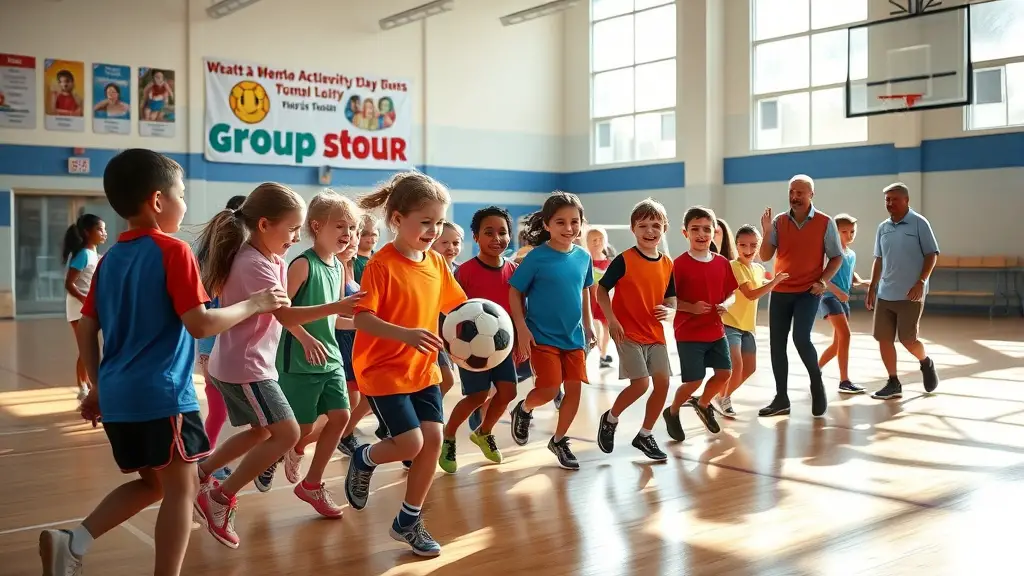
Participating in team sports and group activities offers you more than just physical benefits; it greatly boosts social skills and teamwork. You’ll notice improvements in collaboration and communication, key skills that can enhance your interactions both on and off the field. Plus, engaging in these activities is a fun way to improve your physical health while building lasting friendships.
Social Skills Development
Engaging in team sports and group activities isn’t just about physical fitness; it’s also a powerful way for kids to develop essential social skills. When you involve your child in these programs, they learn valuable communication skills as they interact with teammates and coaches. They practice expressing themselves, listening to others, and working collaboratively towards common goals. This social interaction fosters friendship building, as kids bond over shared experiences and challenges. Additionally, participating in team activities helps them navigate conflicts and develop empathy, vital for lifelong relationships. As they celebrate victories and learn from defeats, they build resilience and a sense of belonging. Ultimately, these experiences contribute greatly to their overall emotional and social development.
Physical Health Improvements
While the social benefits of team sports are significant, the physical health improvements they offer are equally compelling. Participating in team sports can enhance your child’s overall fitness by promoting flexibility training and endurance building. Regular engagement in these activities helps improve cardiovascular health, strengthens muscles, and boosts coordination. Flexibility training, often integrated into warm-ups, reduces the risk of injury and enhances performance in various physical activities. Additionally, endurance building through continuous gameplay fosters stamina, enabling kids to engage in sports longer and with more energy. These physical health benefits not only contribute to a healthier lifestyle but also lay the foundation for lifelong fitness habits. Encouraging your child to join a team can be a fun and effective way to achieve these goals.
Teamwork and Collaboration
When kids participate in team sports, they not only develop their athletic skills but also learn the invaluable lessons of teamwork and collaboration. Engaging in team activities enhances their understanding of team dynamics, helping them appreciate different roles within a group. This experience fosters strong communication skills, essential for resolving conflicts and working toward a common goal.
Moreover, tackling cooperative challenges teaches kids to trust their teammates and adapt to various situations. As they navigate these experiences, they build resilience and problem-solving skills that extend beyond sports. The friendships formed in these environments further enhance their social skills, making them more empathetic and supportive individuals. Ultimately, the lessons learned from teamwork in sports lay the foundation for success in many areas of life.
How to Choose the Right Program for Your Child
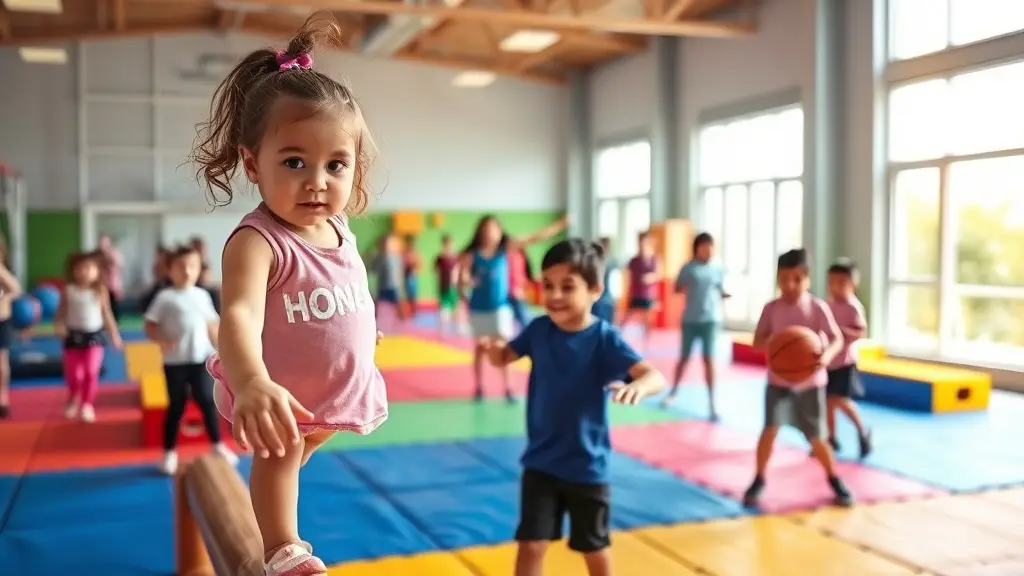
How can you guarantee your child thrives in a gym program? Start by reflecting on their interests and physical abilities. Program selection should align with what excites your child, whether it’s team sports, martial arts, or dance. To help you evaluate options, use the following table:
| Criteria | Questions to Reflect On |
|---|---|
| Child Interests | What activities does your child enjoy? |
| Skill Level | Is your child a beginner or more advanced? |
| Program Structure | Does it offer flexibility and variety? |
| Instructor Experience | Are trainers certified in child development? |
Tips for Encouraging a Lifelong Love of Fitness
To foster a lifelong love of fitness, it is essential to create a positive and enjoyable environment around physical activity. Start by making fitness a family affair; when your kids see you being active, they’re more likely to join in. Schedule regular family activities like biking or hiking to cultivate fitness motivation together.
Encourage your child to explore various sports or activities to discover what they truly enjoy. This can help prevent burnout and keep their enthusiasm alive. Celebrate their achievements, no matter how small, to reinforce their confidence and commitment.
Success Stories: Young Athletes Who Thrived in Gym Programs
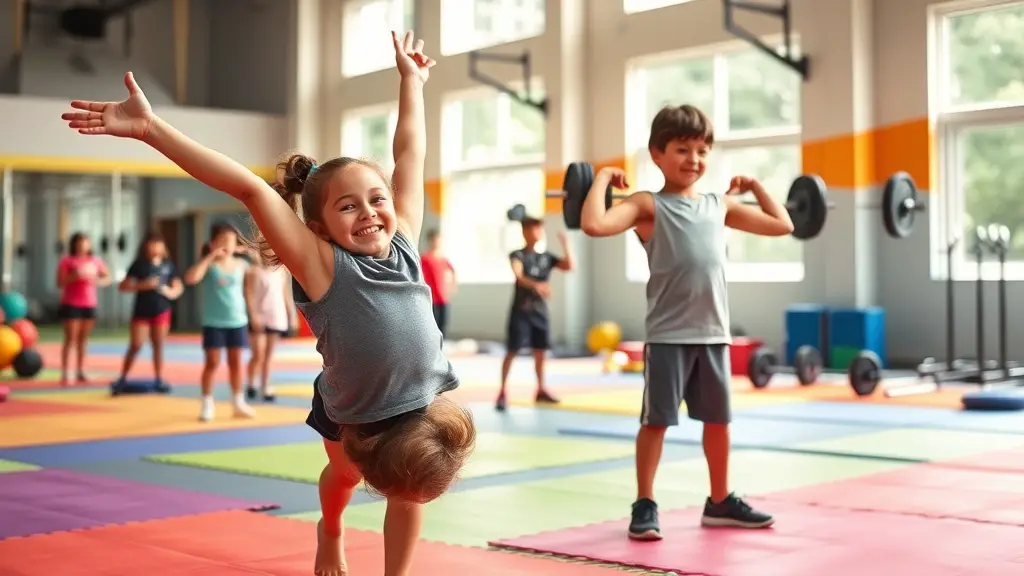
Many young athletes have found their passion and excelled in gym programs designed specifically for them. These inspiring changes often come from dedicated training and supportive environments. Here are a few success stories that highlight the impact of these programs:
| Athlete Name | Achievement |
|---|---|
| Jake Smith | Became a regional champion |
| Mia Johnson | Improved her sprint time by 20% |
| Leo Chen | Won a state-level competition |
| Emma Davis | Secured a college scholarship |
| Sam Lee | shifted to a national team |
Athlete testimonials often emphasize how these programs foster not just physical growth but also confidence and teamwork. By participating in structured gym programs, you can witness similar changes in young athletes around you. With the right guidance and support, the potential for success is limitless, making these gym programs essential for developing future champions. Additionally, these programs often incorporate proper form to ensure safety and effectiveness in training.
Frequently Asked Questions
What Age Should Kids Start Gym Programs?
When it comes to the appropriate age for kids to start gym programs, it really depends on their physical development. Generally, kids can begin engaging in structured activities around age 6, as they’re typically ready to follow basic instructions and enjoy movement. It’s essential to focus on fun and skill-building rather than intense training at this stage. Always consider their individual readiness and interest, ensuring a positive experience that promotes lifelong fitness.
Are There Any Risks Associated With Gym Programs for Kids?
When considering gym programs for kids, it’s important to weigh the risks. Developmental concerns can arise if activities aren’t age-appropriate, potentially leading to improper technique or burnout. Additionally, injury prevention should be a priority; without proper guidance, children may overexert themselves or engage in unsafe practices. Ensuring a well-structured program with knowledgeable instructors can help mitigate these risks, allowing kids to develop physically while enjoying their fitness journey safely.
How Can Parents Support Their Child’S Gym Program?
Did you know that kids who have supportive parents are 80% more likely to stick with their fitness programs? To support your child’s gym program, you can use positive reinforcement to celebrate their achievements, no matter how small. It’s essential to be involved—attend events, ask about their workouts, and show genuine interest in their progress. Your encouragement can boost their confidence and help them develop a lifelong love for fitness.
What Should Kids Wear to Gym Programs?
When choosing what to wear for gym programs, it’s important to prioritize comfort and safety. Kids should wear comfortable clothing that allows for easy movement, like breathable shirts and shorts. Appropriate footwear is essential too; supportive athletic shoes can prevent injuries and enhance performance. Avoid sandals or flip-flops, as they don’t provide the necessary support. Layering can also help, especially if the gym temperature varies. Dressing right sets the stage for a successful experience!
How Do Gym Programs Accommodate Different Skill Levels?
Gym programs accommodate different skill levels by conducting skill assessments to understand each participant’s abilities. This guarantees that everyone starts at a comfortable level. You’ll benefit from individualized coaching tailored to your needs, enabling you to progress at your own pace. Coaches often create diverse activities that challenge various skill sets, fostering a supportive environment. This approach helps you build confidence while developing your skills effectively, ensuring everyone can enjoy and grow in their fitness journey.
